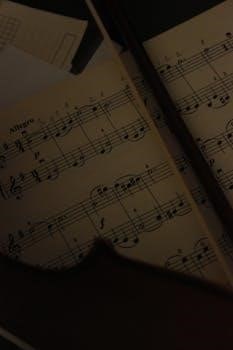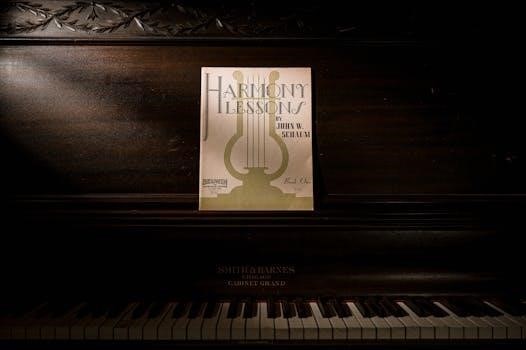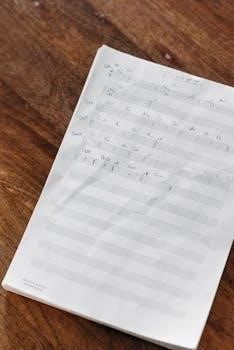Overview of Moonlight Sonata Sheet Music
The “Moonlight Sonata,” officially known as Piano Sonata No. 14, is a widely sought-after piece. Sheet music for this iconic work is readily available, often in PDF format. Many online resources offer free downloads of the scores for the various movements, making it accessible to musicians of all levels. These downloadable scores help musicians in playing, practicing, learning and enjoying this music.
Ludwig van Beethoven’s Piano Sonata No. 14 in C-sharp minor, Op. 27, No. 2, commonly known as the “Moonlight Sonata,” stands as a monumental work in classical piano literature. Completed in 1801 and published in 1802, this piece is not just a technical exercise but a profound emotional journey. The sonata’s nickname, “Moonlight,” wasn’t actually given by Beethoven himself; it came from a critic’s comparison to moonlight on Lake Lucerne after his death. The composition was composed during a period of personal turmoil for Beethoven, as he was coming to terms with his growing deafness. The piece is dedicated to Countess Giulietta Guicciardi, a pupil of Beethoven, with whom he was rumored to be in love. Its structure is unique for its time, placing the most substantial movement, the third, at the end, rather than the traditional first. This unconventional structure, along with its emotional depth, has solidified its place in musical history. The first movement is known for its haunting and melancholic mood.
Popularity and Recognition of the Piece
The “Moonlight Sonata” has achieved unparalleled popularity, becoming one of the most recognizable and beloved pieces in the piano repertoire. Its fame extends far beyond classical music circles, with its haunting melodies appearing in films, television, and popular culture. The first movement, in particular, is instantly recognizable and often used to evoke feelings of romance, melancholy, or introspection. This widespread recognition is due not only to the beautiful melody and emotional depth but also to its accessibility; many amateur and professional pianists alike are drawn to learning and performing the sonata. The “Moonlight Sonata” has been arranged for various instruments, further expanding its reach and appeal. It has been the subject of countless interpretations by pianists worldwide and remains a staple in concert halls and home practice rooms. Its enduring appeal speaks to the power and universality of Beethoven’s musical genius. The availability of free sheet music has no doubt contributed to its popularity.

Finding Free Sheet Music
Numerous online platforms provide free access to “Moonlight Sonata” sheet music. These resources offer scores in PDF format, allowing musicians to download and print them easily. The availability of free sheet music makes it more accessible for music lovers everywhere.
Online Resources for Free PDF Downloads
The internet is a vast repository for free sheet music, and the “Moonlight Sonata” is no exception. Several websites specialize in providing downloadable scores in PDF format, catering to musicians of all skill levels. These platforms often host a variety of arrangements, from the original version to simplified adaptations. Sites like IMSLP (International Music Score Library Project) and MuseScore are great places to start your search. They offer a wide selection of public domain sheet music, ensuring that you can find a free version of Beethoven’s masterpiece. Many of these sites also allow users to download individual movements separately, making it easier to focus on learning specific parts of the piece. Additionally, some sites may include recordings of the music alongside the sheet music, providing a valuable learning aid. Furthermore, some blogs and forums dedicated to piano music frequently share free sheet music links, making them a useful source for finding the “Moonlight Sonata” and other classical pieces. Always be sure to check the licensing terms of the sheet music to ensure you are using it legally. Using these resources, any musician can find and learn the “Moonlight Sonata” without any cost.
Specific Websites Offering Free Scores
Several websites stand out for their extensive collections of free “Moonlight Sonata” sheet music. IMSLP, or the International Music Score Library Project, is a renowned resource for public domain scores, including multiple versions of Beethoven’s sonata. Another excellent site is MuseScore, which not only provides free sheet music but also offers playback functionality, making it easier to learn the piece. Free-scores.com is another valuable platform that hosts a variety of versions of the “Moonlight Sonata” for different instruments and skill levels. Pianocoda.com is also a great resource for finding and downloading the sheet music in PDF for free, they also offer playback of the music recording. Additionally, some smaller websites and blogs, such as freepianosongs.blogspot.com, often feature downloadable versions of the sonata. Websites like Cantorion.org provide public domain sheet music, including the “Moonlight Sonata”, which is beneficial. Musopen.org offers free scores and mp3 downloads of the sonata. Scribd also hosts sheet music of the “Moonlight Sonata.” La Touche Musicale offers easy versions of the score as a PDF download, facilitating learning the piece. These websites collectively offer a rich variety of options for musicians seeking free “Moonlight Sonata” sheet music.

Understanding the Music
The “Moonlight Sonata” is comprised of three distinct movements, each with its own character and structure. The first movement is the well-known Adagio Sostenuto, followed by a more upbeat Allegretto, and concluding with the tempestuous Presto Agitato.
Structure of the Three Movements
Beethoven’s “Moonlight Sonata,” or Piano Sonata No. 14, is structured in three contrasting movements; The first movement, marked Adagio sostenuto, is in C-sharp minor and has a slow, meditative character. It’s written in a modified sonata form, opening with a left-hand octave and a right-hand triplet figure. This movement is known for its haunting melody and delicate textures. The second movement, Allegretto, shifts to D-flat major and offers a lighter, more graceful feel. It serves as a brief respite between the dramatic first and third movements, exhibiting a ternary form with a trio section. The final movement, Presto agitato, returns to C-sharp minor, presenting a stormy and virtuosic display. This sonata-form movement is the most weighty of the three, showcasing Beethoven’s experimentation in placing the most significant part of the sonata last.
The First Movement⁚ Adagio Sostenuto Details
The opening movement of the “Moonlight Sonata,” marked Adagio sostenuto, is in C-sharp minor and unfolds with a profound sense of calm and reflection. The movement commences with a left-hand octave, supporting a right-hand triplet figuration that creates a gentle, flowing texture. This creates the iconic, melancholic sound associated with the piece. The structure of this movement is an approximate truncated sonata form. The melody is haunting and memorable, evoking a sense of nocturnal tranquility. The dynamics are mostly soft, contributing to its introspective nature, though there are subtle shifts in volume throughout. This movement is often described as having a dreamlike quality and is a popular choice for those seeking free sheet music. The unique character of this section made the piece one of the most popular piano pieces ever written.
The Third Movement⁚ Presto Agitato Characteristics
The third movement of Beethoven’s “Moonlight Sonata,” marked Presto agitato, stands in stark contrast to the first movement. This movement is a turbulent and intense display of virtuosity in C minor, demanding significant technical skill from the performer. It’s written in sonata form, making it the most substantial of the three movements. Characterized by rapid scales, arpeggios, and dramatic dynamic shifts, the Presto agitato creates a sense of urgency and unrest. The intense and stormy nature of this movement showcases Beethoven’s experimental approach to sonata form. The piece places the most important and weightiest movement of the sonata last. It serves as a powerful and contrasting conclusion to the sonata, demonstrating the composer’s mastery of musical expression. Many free sheet music versions online include this challenging and rewarding movement.

Additional Information
Beyond the standard piano score, the “Moonlight Sonata” is available in various arrangements. These include simplified versions, transcriptions for other instruments, and educational materials. These resources cater to different skill levels and interests.

Historical Context and Dedication
The “Moonlight Sonata,” officially titled Piano Sonata No. 14 in C-sharp minor, Op. 27, No. 2, was composed by Ludwig van Beethoven in 1801. It was published in 1802. This piece emerged during a period of personal crisis for Beethoven, as he was becoming aware of his encroaching deafness. The sonata is dedicated to Countess Giulietta Guicciardi, a young pupil with whom Beethoven was rumored to be in love. The nickname “Moonlight Sonata” wasn’t given by Beethoven himself. It came later, after his death, when the German poet Ludwig Rellstab compared the first movement of the piece to moonlight reflecting on Lake Lucerne. This evocative description stuck, giving the sonata its popular name. The composition was written between Beethoven’s first and second symphonies. The name, however, wasn’t his own, but was given much later. The story goes that he was in love with a pupil, the countess, and was inspired by the moon when he composed this piece.
Simplified and Easy Piano Arrangements
Recognizing the popularity and the challenging nature of the original composition, many simplified and easy piano arrangements of the “Moonlight Sonata” have been created. These versions aim to make the piece accessible to beginner and intermediate players. These arrangements often feature modifications to the original score, such as simplified rhythms, fewer notes, and easier chord voicings. They retain the essence of the melody while reducing the technical demands. These easy piano scores are very popular and are offered for free download in PDF format on many platforms. They allow music lovers to learn the iconic work without needing advanced piano skills. These arrangements often focus on the first movement, which is the most recognizable and frequently played. The simplified arrangements make this piece available to be played by a wider range of musicians. The La Touche Musicale app, for example, offers an easy version of this piece.
Availability in Different Instrument Transcriptions
Beyond its original form for solo piano, the “Moonlight Sonata” has been transcribed for various other instruments, making it accessible to a wider range of musicians. These transcriptions often adapt the piano score for instruments such as the guitar, flute, violin, and even trumpet. The availability of sheet music for these transcriptions allows musicians to explore the piece in different instrumental settings. These arrangements, too, can be found in downloadable PDF formats. Guitar transcriptions, for instance, may adapt the harmonies and melodic lines to suit the instrument’s capabilities. Likewise, arrangements for flute or violin often focus on the melodic content. These varied transcriptions allow for a fresh interpretation of the beloved sonata. Moreover, they allow musicians who don’t play piano to experience the piece. These transcriptions are freely available, and they allow musicians to play the piece on different instruments. The availability of these versions is a testament to the enduring appeal of this piece;
